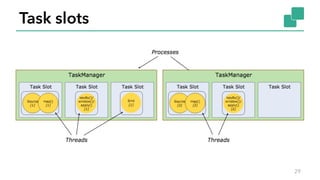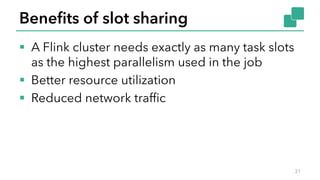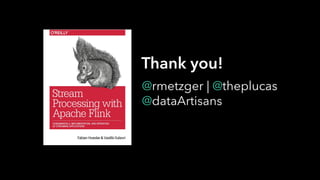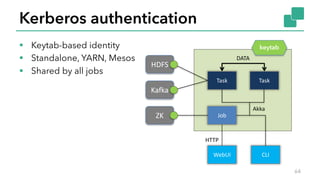Flink Forward Berlin 2017: Robert Metzger - Keep it going - How to reliably and efficiently operate Apache Flink
- 1. 1 Keep it going – How to reliably and efficiently operate Apache Flink Robert Metzger @rmetzger
- 2. About this talk § Part of the Apache Flink training offered by data Artisans § Subjective collection of most frequent ops questions on the user mailing list. Topics § Capacity planning § Deployment best practices § Tuning • Work distribution • Memory configuration • Checkpointing • Serialization § Lessons learned 2
- 4. First step: do the math! § Think through the resource requirements of your problem • Number of keys, state per key • Number of records, record size • Number of state updates • What are your SLAs? (downtime, latency, max throughput) § What resources do you have? • Network capacity (including Kafka, HDFS, etc.) • Disk bandwidth (RocksDB relies on the local disk) • Memory • CPUs 4
- 5. Establish a baseline § Normal operation should be able to avoid back pressure § Add a margin for recovery – these resources will be used to “catch up” § Establish your baseline with checkpointing enabled 5
- 6. Consider spiky loads § For example, operators downstream from a Window won’t be continuously busy § How much downstream parallelism is required depends on how quickly you expect to process these spikes 6
- 7. Example: The Setup § Data: • Message size: 2 KB • Throughput: 1,000,000 msg/sec • Distinct keys: 500,000,000 (aggregation in window: 4 longs per key) • Checkpoint every minute 7 Kafka Source keyBy userId Sliding Window 5m size 1m slide Kafka Sink RocksDB
- 8. Example: The setup § Hardware: • 5 machines • 10 gigabit Ethernet • Each machine running a Flink TaskManager • Disks are attached via the network § Kafka is separate 8 TM 1 TM 2 TM 3 TM 4 TM 5 NAS Kafka
- 9. Example: A machine’s perspective 9 TaskManager n Kafka Source keyBy window Kafka Sink Kafka: 400 MB/s 10 Gigabit Ethernet (Full Duplex) In: 1250 MB/s 10 Gigabit Ethernet (Full Duplex) Out: 1250 MB/s 2 KB * 1,000,000 = 2GB/s 2GB/s / 5 machines = 400 MB/s Shuffle: 320 MB/s 80 MB/s Shuffle: 320 MB/s 400MB/s / 5 receivers = 80MB/s 1 receiver is local, 4 remote: 4 * 80 = 320 MB/s out Kafka: 67 MB/s
- 10. Excursion 1: Window emit 10 How much data is the window emitting? Recap: 500,000,000 unique users (4 longs per key) Sliding window of 5 minutes, 1 minute slide Assumption: For each user, we emit 2 ints (user_id, window_ts) and 4 longs from the aggregation = 2 * 4 bytes + 4 * 8 bytes = 40 bytes per key 100,000,000 (users) * 40 bytes = 4 GB every minute from each machine
- 11. Example: A machine’s perspective 11 TaskManager n Kafka Source keyBy window Kafka Sink Kafka: 400 MB/s 10 Gigabit Ethernet (Full Duplex) In: 1250 MB/s 10 Gigabit Ethernet (Full Duplex) Out: 1250 MB/s 2 KB * 1,000,000 = 2GB/s 2GB/s / 5 machines = 400 MB/s Shuffle: 320 MB/s 80 MB/s Shuffle: 320 MB/s 400MB/s / 5 receivers = 80MB/s 1 receiver is local, 4 remote: 4 * 80 = 320 MB/s out Kafka: 67 MB/s 4 GB / minute => 67 MB/ second (on average)
- 12. Example: Result 12 TaskManager n Kafka Source keyBy window Kafka Sink Kafka: 400 MB/s 10 Gigabit Ethernet (Full Duplex) In: 1250 MB/s 10 Gigabit Ethernet (Full Duplex) Out: 1250 MB/s Shuffle: 320 MB/s 80 MB/s Shuffle: 320 MB/s Kafka: 67 MB/s Total In: 720 MB/s Total Out: 387 MB/s
- 13. Example: Result 13 TaskManager n Kafka Source keyBy window Kafka Sink Kafka: 400 mb/s 10 Gigabit Ethernet (Full Duplex) In: 1250 mb/s 10 Gigabit Ethernet (Full Duplex) Out: 1250 mb/s Shuffle: 320 mb/s 80 mb/s Shuffle: 320 mb/s Kafka: 67 mb/s Total In: 720 mb/s Total Out: 387 mb/s WRONG. We forgot: • Disk Access to RocksDB • Checkpointing
- 14. Example: Intermediate Result 14 TaskManager n Kafka Source keyBy window Kafka Sink Kafka: 400 MB/s 10 Gigabit Ethernet (Full Duplex) In: 1250 MB/s 10 Gigabit Ethernet (Full Duplex) Out: 1250 MB/s Shuffle: 320 MB/s Shuffle: 320 MB/s Kafka: 67 MB/s Disk read: ? Disk write: ?
- 15. Excursion 2: Window state access 15 How is the Window operator accessing state? Recap: 1,000,000 msg/sec. Sliding window of 5 minutes, 1 minute slide Assumption: For each user, we store 2 ints (user_id, window_ts) and 4 longs from the aggregation = 2 * 4 bytes + 4 * 8 bytes = 40 bytes per key 5 minute window (window_ts) key (user_id) value (long, long, long, long) Incoming data For each incoming record, update aggregations in 5 windows
- 16. Excursion 2: Window state access 16 How is the Window operator accessing state? For each key-value access, we need to retrieve 40 bytes from disk, update the aggregates and put 40 bytes back per machine: 40 bytes * 5 windows * 200,000 msg/sec = 40 MB/s
- 17. Example: Intermediate Result 17 TaskManager n Kafka Source keyBy window Kafka Sink Kafka: 400 MB/s 10 Gigabit Ethernet (Full Duplex) In: 1250 MB/s 10 Gigabit Ethernet (Full Duplex) Out: 1250 MB/s Shuffle: 320 MB/s Shuffle: 320 MB/s Kafka: 67 MB/s Total In: 760 MB/s Total Out: 427 MB/s Disk read: 40 MB/s Disk write: 40 MB/s
- 18. Excursion 3: Checkpointing 18 How much state are we checkpointing? per machine: 40 bytes * 5 windows * 100,000,000 keys = 20 GB We checkpoint every minute, so 20 GB / 60 seconds = 333 MB/s
- 19. Example: Final Result 19 TaskManager n Kafka Source keyBy window Kafka Sink Kafka: 400 MB/s 10 Gigabit Ethernet (Full Duplex) In: 1250 MB/s 10 Gigabit Ethernet (Full Duplex) Out: 1250 MB/s Shuffle: 320 MB/s Shuffle: 320 MB/s Kafka: 67 MB/s Total In: 760 MB/s Total Out: 760 MB/s Disk read: 40 MB/s Disk write: 40 MB/s Checkpoints: 333 MB/s
- 20. Example: Network requirements 20 TM 2 TM 3 TM 4 TM 5 TM 1 NAS In: 760 MB/s Out: 760 MB/s 5x 80 MB/s = 400 MB/s Kafka 400 MB/s * 5 + 67 MB/s * 5 = 2335 MB/s Overall network traffic: 2 * 760 * 5 + 400 + 2335 = 10335 MB/s = 82,68 Gigabit/s
- 21. Deployment Best Practices Things you should consider before putting a job in production 21
- 22. Deployment Options § Hadoop YARN integration • Cloudera, Hortonworks, MapR, … • Amazon Elastic MapReduce (EMR), Google Cloud dataproc § Mesos & DC/OS integration § Standalone Cluster (“native”) • provided bash scripts • provided Docker images 22 Flink in containerland DAY 3 / 3:20 PM - 4:00 PM MASCHINENHAUS
- 23. Choose your state backend Name Working state State backup Snapshotting RocksDBStateBackend Local disk (tmp directory) Distributed file system Asynchronously • Good for state larger than available memory • Supports incremental checkpoints • Rule of thumb: 10x slower than memory-based backends FsStateBackend JVM Heap Distributed file system Synchronous / Async • Fast, requires large heap MemoryStateBackend JVM Heap JobManager JVM Heap Synchronous / Async • Good for testing and experimentation with small state (locally) 23
- 25. Check the production readiness list § Explicitly set the max parallelism for rescaling • 0 < parallelism <= max parallelism <= 32768 • Max parallelism > 128 has some impact on performance and state size § Set UUIDs for all operators to allow changing the application between restores • By default Flink generates UUIDs § Use the new ListCheckpointed and CheckpointedFunction interfaces 25 Production Readiness Checklist: https://ci.apache.org/projects/flink/flink-docs-release- 1.3/ops/production_ready.html
- 26. Tuning: CPU usage / work distribution 26
- 27. Configure parallelism / slots § These settings influence how the work is spread across the available CPUs § 1 CPU per slot is common § multiple CPUs per slot makes sense if one slot (i.e. one parallel instance of the job) performs many CPU intensive operations 27
- 29. Task slots 29
- 30. Slot sharing (parallelism now 6) 30
- 31. Benefits of slot sharing § A Flink cluster needs exactly as many task slots as the highest parallelism used in the job § Better resource utilization § Reduced network traffic 31
- 32. What can you do? § Number of TaskManagers vs number of slots per TM § Set slots per TaskManager § Set parallelism per operator § Control operator chaining behavior § Set slot sharing groups to break operators into different slots 32
- 34. Memory in Flink (on YARN) 34 YARN Container Limit JVM Heap (limited by Xmx parameter) Other JVM allocations: Classes, metadata, DirectByteBuffers JVM process size Netty RocksDB? Network buffersInternal Flink services User code (window contents, …) Memory Manager
- 35. Example: Memory in Flink 35 YARN Container Limit: 2000 MB JVM Heap: Xmx: 1500MB = 2000 * 0.75 (default cutoff is 25%) Other JVM allocations: Classes, metadata, stacks, … JVM process size: < 2000 MB Netty ~64MB RocksDB? MemoryManager? up to 70% of the available heap § TaskManager: 2000 MB on YARN “containerized.heap-cutoff-ratio” Container request size “taskmanager.memory.fraction“ RocksDB Config Network Buffers „taskmanager.network. memory.min“ (64MB) and „.max“ (1GB)
- 37. Checkpointing § Measure, analyze and try out! § Configure a checkpointing interval • How much can you afford to reprocess on restore? • How many resources are consumed by the checkpointing? (cost in throughput and latency) § Fine-tuning • “min pause between checkpoints” • “checkpoint timeout” • “concurrent checkpoints” § Configure exactly once / at least once • exactly once does buffer alignment spilling (can affect latency) 37
- 38. 38
- 39. Conclusion 39
- 40. Tuning Approaches § 1. Develop / optimize job locally • Use data generator / small sample dataset • Check the logs for warnings • Check the UI for backpressure, throughput, metrics • Debug / profile locally § 2. Optimize on cluster • Checkpointing, parallelism, slots, RocksDB, network config, … 40
- 41. The usual suspects § Inefficient serialization § Inefficient dataflow graph • Too many repartitionings; blocking I/O § Slow external systems § Slow network, slow disks § Checkpointing configuration 41
- 42. Q & A Let’s discuss … 4 2
- 43. 4 Thank you! @rmetzger | @theplucas @dataArtisans
- 45. Set UUIDs for all (stateful) operators § Operator UUIDs are needed to restore state from a savepoint § Flink will auto—generate UUIDs, but this results in fragile snapshots. § Setting UUIDs in the API: DataStream<String> stream = env .addSource(new StatefulSource()) .uid("source-id") // ID for the source operator .map(new StatefulMapper()) .uid("mapper-id") // ID for the mapper .print(); 45
- 46. Use the savepoint tool for deletions § Savepoint files contain only metadata and depend on the checkpoint files • bin/flink savepoint -d :savepointPath § There is work in progress to make savepoints self-contained à deletion / relocation will be much easier 46
- 47. Avoid the deprecated state APIs § Using the Checkpointed interface will prevent you from rescaling your job § Use ListCheckpointed (like Checkpointed, but redistributeble) or CheckpointedFunction (full flexibility) instead. Production Readiness Checklist: https://ci.apache.org/projects/flink/flink-docs-release- 1.3/ops/production_ready.html 47
- 48. Explicitly set max parallelism § Changing this parameter is painful • requires a complete restart and loss of all checkpointed/savepointed state § 0 < parallelism <= max parallelism <= 32768 § Max parallelism > 128 has some impact on performance and state size 48
- 49. RocksDB § If you have plenty of memory, be generous with RocksDB (note: RocksDB does not allocate its memory from the JVM’s heap!). When allocating more memory for RocksDB on YARN, increase the memory cutoff (= smaller heap) § RocksDB has many tuning parameters. § Flink offers predefined collections of options: • SPINNING_DISK_OPTIMIZED_HIGH_MEM • FLASH_SSD_OPTIMIZED 49
- 51. (de)serialization is expensive § Getting this wrong can have a huge impact § But don’t overthink it 51
- 52. Serialization in Flink § Flink has its own serialization framework, which is used for • Basic types (Java primitives and their boxed form) • Primitive arrays and Object arrays • Tuples • Scala case classes • POJOs § Otherwise Flink falls back to Kryo 52
- 53. A note on custom serializers / parsers § Avoid obvious anti-patterns, e.g. creating a new JSON parser for every record 53 Source map() String keyBy()/ window()/ apply() Sink Source map() keyBy()/ window()/ apply() § Many sources (e.g. Kafka) can parse JSON directly § Avoid, if possible, to ship the schema with every record String
- 54. What else? § You should register types with Kryo, e.g., • env.registerTypeWithKryoSerializer(DateTime.class, JodaDateTimeSerializer.class) § You should register any subtypes; this can increase performance a lot § You can use serializers from other systems, like Protobuf or Thrift with Kyro by registering the types (and serializers) § Avoid expensive types, e.g. Collections, large records § Do not change serializers or type registrations if you are restoring from a savepoint 54
- 56. Deployment Options § Hadoop YARN integration • Cloudera, Hortonworks, MapR, … • Amazon Elastic MapReduce (EMR), Google Cloud dataproc § Mesos & DC/OS integration § Standalone Cluster (“native”) • provided bash scripts • provided Docker images 56 Flink in containerland DAY 3 / 3:20 PM - 4:00 PM MASCHINENHAUS
- 57. Deployment Options § Docs and best-practices coming soon for • Kubernetes • Docker Swarm à Check Flink Documentation details! 57 Flink in containerland DAY 3 / 3:20 PM - 4:00 PM MASCHINENHAUS
- 59. YARN / Mesos HA § Run only one JobManager § Restarts managed by the cluster framework § For HA on YARN, we recommend using at least Hadoop 2.5.0 (due to a critical bug in 2.4) § Zookeeper is always required 59
- 60. Standalone cluster HA § Run standby JobManagers § Zookeeper manages JobManager failover and restarts § TaskManager failures are resolved by the JobManager à Use custom tool to ensure a certain number of Job- and TaskManagers 60
- 62. Outline 1. Hadoop delegation tokens 2. Kerberos authentication 3. SSL 62
- 63. § Quite limited • YARN only • Hadoop services only • Tokens expire Hadoop delegation tokens 63 DATA Job Task Task HDFS Kafka ZK WebUI CLI HTTP Akka token
- 64. § Keytab-based identity § Standalone, YARN, Mesos § Shared by all jobs Kerberos authentication 64 DATA Job Task Task HDFS Kafka ZK WebUI CLI HTTP Akka keytab
- 65. SSL § taskmanager.data.ssl.enabled: communication between task managers § blob.service.ssl.enabled: client/server blob service § akka.ssl.enabled: akka-based control connection between the flink client, jobmanager and taskmanager § jobmanager.web.ssl.enabled: https for WebUI 65 DATA Job Task Task HDFS Kafka ZK WebUI CLI HTTPS Akka keytab certs
- 66. Limitations § The clients are not authenticated to the cluster § All the secrets known to a Flink job are exposed to everyone who can connect to the cluster's endpoint § Exploring SSL mutual authentication 66


































































